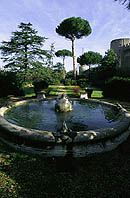St. Peter's in Vatican
Vatican Gardens
 (Giardini Vaticani) (Guided tour only. See: Vital Data). The Arch of the Bell (Arco della Campana) is Swiss-guarded, and though their halberds have been changed to rifles, they are still in their colorful and elegant 16C costumes.
(Giardini Vaticani) (Guided tour only. See: Vital Data). The Arch of the Bell (Arco della Campana) is Swiss-guarded, and though their halberds have been changed to rifles, they are still in their colorful and elegant 16C costumes.
Through the big square and under the first arch of the Sacristy of St. Peter's you will see a black and white stone design on the ground, showing where the obelisk was before its removal to the center of St. Peter's Square.
This was the center of the “spina” (see Circus Maximus) of the Circus of Caligula and Nero where many Christians, including Peter, were martyred, among other unfortunates: prisoners of war, criminals, people who had fallen into disfavor with the authorities or the Emperor.
The gardens are well laid out, although they are being filled up with too many buildings. Stretching up the hill, they are peppered with gifts to various Popes: fountains, statues, etc.
The loveliest part is the intimate Casina of Pope Pio IV. In 1558 this Medici Pope had Ligorio build, with Perruzzi's help, two pleasure pavilions facing each. An elliptical walled court lies between them, with seats running the length of the walls. The buildings are highly decorated in plasterwork with columns, niches and statues. Cherubs can be spotted climbing all over the fountain in the center.
The Mosaic Studio
(Bottega del Mosaico) (See: Vital Data). It was set up to copy all the oil paintings in St. Peter's which were damaged over the centuries. They even had their own glass factory making square pizzas of colored glass ready to be chopped into mosaics.
These “pizze”, embossed with the Vatican crest, were made in...22,000 colors! Orders poured in from all over the Christian world for altars, Today, decorative themes can be ordered as well as religious ones.
In 1731 a new type of glass mosaic was invented with a non-reflective oily finish. The Vatican bought this patent and stopped buying shiny glass mosaic pieces from Venice. Today, all the pictures in St. Peter's are really mosaics, except one. The earliest example now in the basilica is just to the left in the right transept, representing "St. Peter on Lake Tiberius." It took six years for the mosaicist Cristofari to create this masterpiece from Ricciolini's painting.